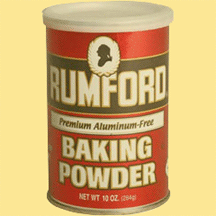 |
|||

|
It does not immediately come to mind that making things “as easy as sliced bread” has not always meant what it means today. In fact, making any kind of bread used to be a real hassle. For most of history bread-making was an arduous struggle. It was not until the 1830s that bakers universally realized that they could add a few supplies to bread dough to ease the process. Adding sodium bicarbonate and sour milk to dough bonds certain chemicals together which creates carbon dioxide. When the carbon dioxide is heated up and expands in the dough, the bread rises. This concept made bread-baking easier, but worked better in cakes than bread and was somewhat unpredictable. Just how sour the milk was would alter the chemical reaction. Always intuitive, break bakers began to use cream of tartar (a by-product of wine fermentation) to standardize the process because of its more predictable reactions. A German-educated Harvard professor and chemist was able to provide the solution for an ideal baking powder. Eben Norton Horsford discovered that he could replace the pricey and hard-to-find cream of tartar with calcium acid phosphate. He received a patent on April 26, 1856, for his procedure to manufacture this chemical, and began to manufacture the calcium acid phosphate at the Rumford Chemical Works, a plant that he managed with his partner George Wilson in Rhode Island. The Rumford Chemical Works began to sell Horsford's Bread Preparation, a packaged amount of calcium acid phosphate and sodium bicarbonate perfect for baking. Horsford realized that he had replaced the cream of tartar but not the extra struggle of having to mix the two chemicals together. Horsford’s next innovation was adding corn starch to his two other ingredients, which ensured that they remained dry enough to be combined before entering the baker’s bowl. Finely ground calcium acid phosphate and sodium bicarbonate mixed with corn starch prevented any chemical reactions before baking began, and baking powder as we know it was created. Horsford’s baking powder was first sold under his name, but was soon changed to Rumford Baking Powder, which is a staple in almost every American household to this day. The same key ingredients — calcium acid phosphate, sodium bicarbonate, and corn starch — remain in the same proportions as Horsford himself determined. The only real change to his original recipe came in the late 1880s, when the introduction of calcium phosphate mining eliminated the need for the ground up beef bones which were previously necessary. Horsford remained interested in chemistry and nutrition until about the time of the Civil War. After the war, he largely abandoned science and took up other pursuits. One of his most empassioned endeavors was trying to prove that the Vikings had reached Cambridge during their time of exploration. The Viking longboat prows on the base of the Longfellow bridge are an homage to Horsford’s efforts. Eben Horsford remained in Cambridge until his death on January 1, 1893. Today, Rumford Baking Powder remains the leading orthophosphate baking powder in the United States. Hulman & Co. acquired the Rumford brand when it purchased the Rumford Chemical Works of East Providence, RI in 1950, but Horsford’s innovation is still sold to this day. Sources:
|
||

